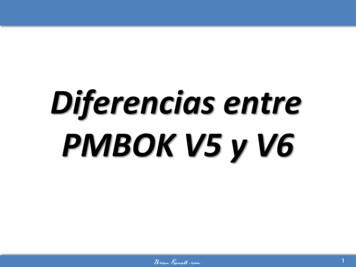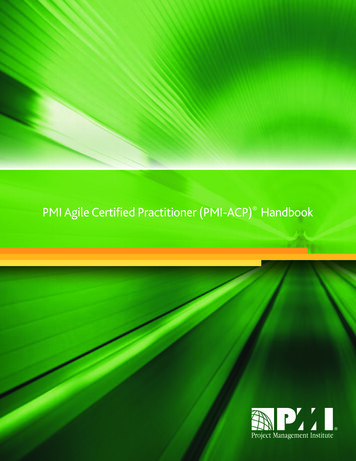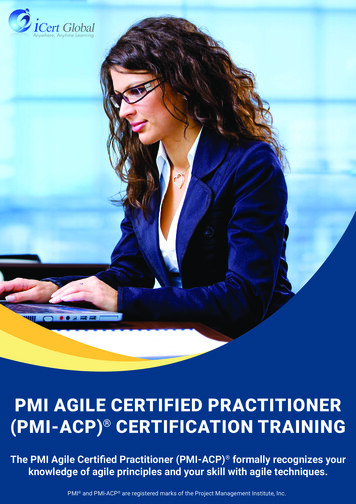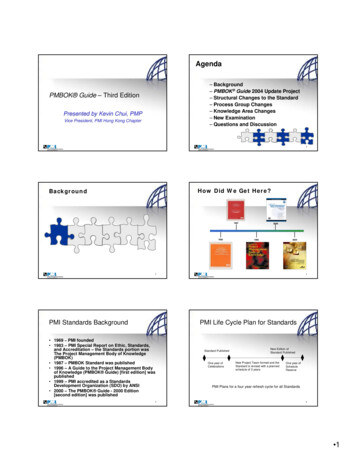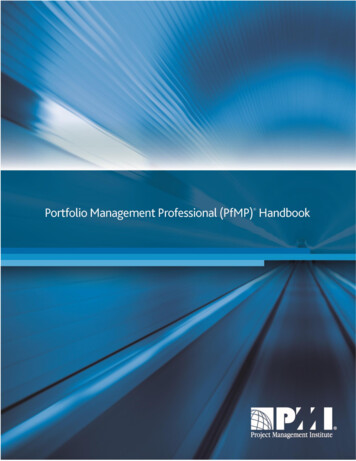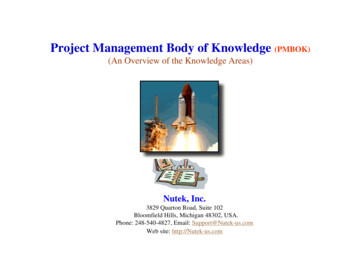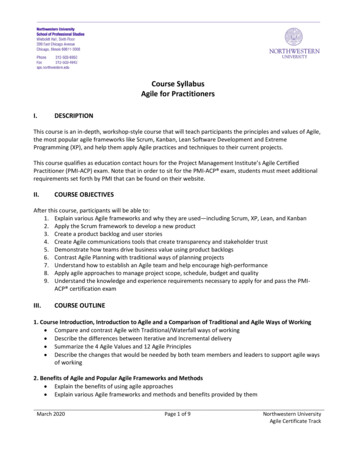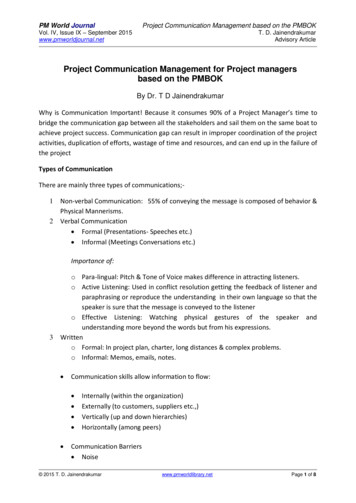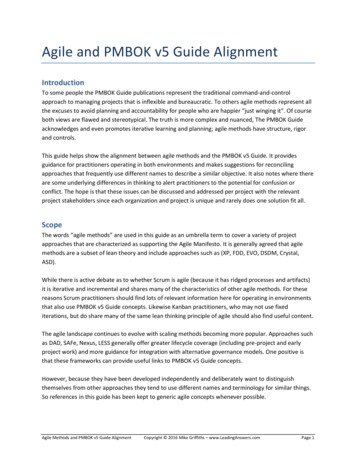
Transcription
Agile and PMBOK v5 Guide AlignmentIntroductionTo some people the PMBOK Guide publications represent the traditional command-and-controlapproach to managing projects that is inflexible and bureaucratic. To others agile methods represent allthe excuses to avoid planning and accountability for people who are happier “just winging it”. Of courseboth views are flawed and stereotypical. The truth is more complex and nuanced, The PMBOK Guideacknowledges and even promotes iterative learning and planning; agile methods have structure, rigorand controls.This guide helps show the alignment between agile methods and the PMBOK v5 Guide. It providesguidance for practitioners operating in both environments and makes suggestions for reconcilingapproaches that frequently use different names to describe a similar objective. It also notes where thereare some underlying differences in thinking to alert practitioners to the potential for confusion orconflict. The hope is that these issues can be discussed and addressed per project with the relevantproject stakeholders since each organization and project is unique and rarely does one solution fit all.ScopeThe words “agile methods” are used in this guide as an umbrella term to cover a variety of projectapproaches that are characterized as supporting the Agile Manifesto. It is generally agreed that agilemethods are a subset of lean theory and include approaches such as (XP, FDD, EVO, DSDM, Crystal,ASD).While there is active debate as to whether Scrum is agile (because it has ridged processes and artifacts)it is iterative and incremental and shares many of the characteristics of other agile methods. For thesereasons Scrum practitioners should find lots of relevant information here for operating in environmentsthat also use PMBOK v5 Guide concepts. Likewise Kanban practitioners, who may not use fixediterations, but do share many of the same lean thinking principle of agile should also find useful content.The agile landscape continues to evolve with scaling methods becoming more popular. Approaches suchas DAD, SAFe, Nexus, LESS generally offer greater lifecycle coverage (including pre-project and earlyproject work) and more guidance for integration with alternative governance models. One positive isthat these frameworks can provide useful links to PMBOK v5 Guide concepts.However, because they have been developed independently and deliberately want to distinguishthemselves from other approaches they tend to use different names and terminology for similar things.So references in this guide has been kept to generic agile concepts whenever possible.Agile Methods and PMBOK v5 Guide AlignmentCopyright 2016 Mike Griffiths – www.LeadingAnswers.comPage 1
Agile to PMBOK Mapping/AlignmentConceptsComparing agile methods to the processes and knowledge areas in the PMBOK v5 Guide shows manyobvious alignments and some initially apparent conflicts. While the overall destination of successfulprojects is the same with high quality deliverables and satisfied stakeholders, often the direction takento reach this destination can appear different.As an example the PMBOK v5 Guide describes a comprehensive set of planning activities to undertakeprior to project execution. Agile approaches, recommend a lighter approach to upfront planning withmore effort to schedule subsequent plan updates. Agile methods accept a comprehensiveunderstanding of desired scope and technical complexity is often not knowable at the start of theproject. Instead execution of known components will be more effective at uncovering the remainingscope and complexity than longer, more rigorous initial planning.These concepts of emergent detail and repeating planning cycles are not at odds with the PMBOK viewand align perfectly with the concepts of Rolling Wave Planning and Progressive Elaboration. Instead it isthe emphasis and coverage depth these approaches receive in the guides that differ. The PMBOK Guidefor instance dedicates 26 pages to cover the 10 types of planning and just 4 paragraphs to describe theongoing and iterative nature of plan evolution. Agile methods on the other hand, typically dedicate anequal amount of content to describe the ongoing, collaborative nature of (re)planning as they do therole and need for plans. While no content conflicts between the guides the balance of initial vs. ongoingplanning will likely seem quite different to readers.Project OrganizationThe first chapter of the PMBOK v5 Guide discusses project organization and the hierarchy of portfolios,programs and projects. Since many agile frameworks like DSDM start before a project is formed andextends after the project is complete they can provide strong ties to programs and portfolios thatcontain projects. These pre and post project activities are undertaken through feasibility studies early inthe lifecycle and then benefits realization deliverables after the project completes.The PMBOK v5 Guide describes how the business benefits of a project may not be achieved for someperiod after the project completes and so should be measured at a longer term program level. By havingbenefits assessment deliverables within the agile frameworks, like the DSDM framework, projectstakeholders are reminded of the longer term, bigger picture goals at the execution level and are lesslikely to take a “get it in and done” approach to delivery. Knowing how things will later be measured anddeemed a success or failure influences project behaviours and actions.Agile Methods and PMBOK v5 Guide AlignmentCopyright 2016 Mike Griffiths – www.LeadingAnswers.comPage 2
Organizational Influences and Project LifecyclesChapter 2 of the PMBOK v5 Guide deals with organizational influences and project lifecycles.Organizational influences include elements about culture and style, communications, organizationalstructures, process and deliverables, and all the things that define the thought processes and workingpractices of an organization.Agile frameworks are by design flexible and can be adapted to work within for most organizations, butsome of these elements can be enablers or potential barriers. Culturally agile methods take a resultsfocussed, flexible and proactive approach to project execution. Tools like agile suitability filters ask ifusers are accustomed to working in a results focused approach. The use of demos and frequentinteraction with the business representatives is easier to arrange when there are not hierarchicalboundaries to communications or intermediary roles. As such agile approaches work best whenorganizational norms support a free flow of communication across roles and divisional boundaries.Weak matrix and projectized organizational structures work well for sharing project information thatmay not be extensively documented. In contrast, strong matrix organizations where people report intospecializations and do not usually work as cross functional teams typically require more formaldocumentation to undertake work.This extra documentation is to help provide context when people task switch between many projects.While task switching has been found to be an inefficient and error prone way of working, it is a reality inmany large organizations with matrix reporting structures. Agile teams are recommended to bededicated to a single project as much as possible and leverage tacit (unwritten) knowledge as a moreefficient way of working.The PMBOK v5 Guides discussion of Organizational Process Assets includes standards aroundprocedures, documents and lessons learned databases. Agile lifecycles work well with theserecommendations having defined (albeit lightweight) product definitions and the retrospective reviewcycle of every iteration provides information for the lessons learned database.Project Stakeholders and Team StructuresThe PMBOK v5 Guide defines a project stakeholder as anyone who may affect, be affected by, orperceive themselves to be affected by a decision, activity, or outcome of a project. Stakeholders includemembers of the project team as well as interested entities who may be internal and external to theorganization. The project manager must manage the influences of these various stakeholders in relationto the project requirements to ensure a successful outcome. These classes of stakeholders and theirinteraction with the project are depicted below:Agile Methods and PMBOK v5 Guide AlignmentCopyright 2016 Mike Griffiths – www.LeadingAnswers.comPage 3
Figure 3 – From the PMBOK v5 Guide – Project Stakeholders and Project TeamAgile Methods and PMBOK v5 Guide AlignmentCopyright 2016 Mike Griffiths – www.LeadingAnswers.comPage 4
Figure 4 – From Disciplined Agile Delivery (DAD) – RolesAgile methods have compatible models for project stakeholders and team members. They describes aproject team with solution development members, project members including business representationalong with supporting facilitator and coach roles. Together these roles form the same composition andpurpose as the “Project Team” in the PMBOK diagram.An element that differs and is worth mentioning on agile project teams is the preference for SelfDirecting Teams. The PMBOK v5 Guide allows for teams to be tightly managed and in a command-andcontrol style or to operate in a collaborative empowered way. Both models and any point on thespectrum between these extremes work within the PMBOK view. Agile methods however recommendSelf Directed Teams that have more autonomy.Agile approaches recommend the use of self directed teams since projects with high rates of change donot have time to manage work in bureaucratic approaches and wish to avoid “I did my job” mentalitiesthat can sometimes arise in tightly managed teamsAgile Methods and PMBOK v5 Guide AlignmentCopyright 2016 Mike Griffiths – www.LeadingAnswers.comPage 5
Tightly Managed TeamsTake directionsSeek individual rewardFocus on low level objectivesCompeteComply with process, regardless of outcomeReact in emergenciesSelf Directing TeamsTake initiativeFocus on team contributionsConcentrate on solutionsCo-operateContinually look for better ways of workingTake steps to prevent emergenciesSo, while there is no conflict between agile recommendations (the use of Self Directed Teams) and thePMBOK’s agnostic view on team styles, organizations considering agile approaches should consider thepracticality and organizational fit of self directed teams.Process Groups and Knowledge Areas and Project LifecyclesThe PMBOK Guide describes five process groups involved in running a project: Initiating Planning Executing Monitoring and Controlling ClosingThese can be depicted as a single project flow as follows:Figure 5 – From the PMBOK v5 Guide - One approach to managing a projectHowever the PMBOK v5 Guide is clear to point out that the processes can also be repeated with a singleproject multiple times and overlapped.Agile Methods and PMBOK v5 Guide AlignmentCopyright 2016 Mike Griffiths – www.LeadingAnswers.comPage 6
Figure 6 – From the PMBOK v5 Guide - Example of a three phase projectFigure 7 – From the PMBOK v5 Guide - Example of a project with overlapping phasesUsing these PMBOK v5 Guide images as a starting point it is easy to create a model that is compatiblewith elements of a full lifecycle agile approach such as Disciplined Agile Delivery (DAD) or DSDM. Thediagram below shows how the five PMBOK processes map to the pre-project and execution work of athree release project.Figure 8 – PMI and DSDM lifecycle elements for a project with 3 release cyclesInitiating Process GroupMost of the extended lifecycle agile approaches that include DSDM, DAD, and SAFe contain early projectactivities that correspond to the PMBOK v5 Guide’s Initiating Process Group activities. They all cover theearly project activities and complement the goals of clearly defining the project parameters andconfirming feasibility.Agile Methods and PMBOK v5 Guide AlignmentCopyright 2016 Mike Griffiths – www.LeadingAnswers.comPage 7
Planning Process GroupThe PMBOK Guide set of planning processes describe all the activities performed to define the totalscope, objectives and course of action for a project. It assumes that with sufficient analysis these tasksare knowable and development is then largely the execution of these plans. The PMBOK v5 Guidedescribes the concepts of Progressive Elaboration and Rolling Wave Planning as effective mechanism totune plans to emerging details and they act as accepted extensions to generally detailed initial plan.Agile approaches to planning are deliberately more incremental and recommend a process that iteratesto discover and refine scope. These concepts can be made to exist within the PMBOK framework too bymaking the PMBOK ideas of Progressive Elaboration and Rolling Wave Planning more of a central themerather than supporting process.When describing an agile project in a PMBOK environment it is important to explain initial plans will bedeliberately light and progressively enriched as early iterations clarify understandings and provideadditional information. It is also useful to describe the ownership shift from project manager as primaryplanner to the team as primary planner. Agile methods encourage shifting much of the planningresponsibilities to the team (including business representation) which takes the form of release anditeration planning and backlog prioritization.Executing Process GroupThe PMBOK v5 Guide’s approach to execution is to “go do the items identified in the project plan” andupdate and re-baseline the plan if changes occur. These changes may be necessary due to changes inactivity durations and resource productivity or availability based on unanticipated risks and issues. Tosome people there is an assumption that planned activities are fully understood prior to starting workand complete according to plan.Agile methods employ a more dynamic execution approach where higher level of replanning are thenorm. This is due to the complex nature of software projects and high rates of change, due to technicaluncertainty and requirements evolution. It is assumed that all aspects of work are not knowable inadvance and learning with adaptation will be necessary to complete these tasks.Execution on an agile project occurs through multiple iterations. Each iteration is a short, immovable,focussed time period to undertake work followed by a demo and retrospective review. Theretrospective allows any issues with execution or scope changes to be discussed in a timely fashion. Italso acts as a review point to check progress against the plan and determine if any changes to theproject execution process, scope or schedule are necessary.Monitoring and Controlling Process GroupThe Monitoring and Controlling processes described in the PMBOK V5 Guide explain how to track,review and manage progress. They outline how to identify where changes to the plan are required andAgile Methods and PMBOK v5 Guide AlignmentCopyright 2016 Mike Griffiths – www.LeadingAnswers.comPage 8
then how make the required changes. The overall view is akin to a thermostat model, once the plan ismade measurements are used to determine if adjustments during project execution are necessary whenfeedback indicates acceptable tolerances have been breached.Agile approaches use different techniques for monitoring, with more demos and feedback rather thantests to specification. These demos and business discussions are more subjective, but eventual success isoften a subjective measure. In addition to the Thermostat Model of feedback a ScientificExperimentation Model is used. The Scientific Experimentation Model makes experimentation andlearning a key part of the process for the project.The retrospective review that follows an agile iteration is one visible component of the ScientificExperimentation model in play. Iterations can be created to trial new technology or test new processchanges in addition to building new functionality. These short cycles provide important feedback onwhat is working and what needs further tuning.Closing Process GroupThe goals of the Closing Process group include verifying all the defined processes are complete,conducting post project or post phase reviews and closing out procurement. The Closing Process groupalso gets executed whenever a project or phase is closed prematurely.On an agile project lessons learned are collected as the project progresses after every iteration ratherthan at the end of the project. This has two main advantages, the first being lessons can be acted onimmediately to get the benefits on this project rather than a subsequent one, the second being morelessons learned information is captured since it is done more frequently.Asking a team to think back a year to the requirements gathering portion of the project and recall “Whatwent well?” and “What did not go well?” is not as likely to yield as much useful information as pausingevery two weeks to record this information while it is still fresh.Work on an agile project is prioritized to undertake the highest business value items first. This meansthat if the Closing Process group is exercised to prematurely close a project or phase on an agile projectthere is a high chance that some useful business value will already have been generated. Perhapsmaking the premature closure less of a failure and more of an early benefits realization, quick win, orproof of concept for the business rather than purely sunk costs.PMBOK V5 Guide Knowledge AreasThe PMBOK v5 Guide has 10 chapters describing knowledge areas of generally accepted projectmanagement good practice.The 10 Knowledge Areas referenced by their PMBOK v5 Guide Chapter numbers are:Agile Methods and PMBOK v5 Guide AlignmentCopyright 2016 Mike Griffiths – www.LeadingAnswers.comPage 9
4.5.6.7.8.9.10.11.12.13.Project Integration ManagementProject Scope ManagementProject Time ManagementProject Cost ManagementProject Quality ManagementProject Human Resources ManagementProject Communications ManagementProject Risk managementProject Procurement ManagementProject Stakeholder ManagementA mapping of each PMBOK v5 Guide knowledge area to agile principals, tools and techniques can befound in “Appendix 1 – Agile and PMBOK v5 Guide Knowledge Area Mappings”. The appendix acts as aguide for practitioners looking for specific explanations regarding project management practices.Agile Alignment with Other PMI StandardsPMI Software Extension to the PMBOKThe Software Extension to the PMBOK Guide is the newest standard to be published by the PMI on usingthe PMBOK Guide for software projects. It covers the full range of software development life cycles fromHighly Predictive, waterfall approaches to Highly Adaptive agile, lean and kanban based approaches.Agile methods fit perfectly with the Adaptive category discussions of effectively executing softwareprojects.PMI Standard for Program ManagementThe PMI Standard for Program Management, now in its third edition, helps program managers deal witha variety of factors such as linking projects under one program and providing the best allotment ofresources between those projects. The standard is a valuable tool for program, project and portfoliomanagers alike, as well as project stakeholders and senior management.Full lifecycle agile methodologies such as SAFe, DAD and DSDM provides an excellent fit with largerenterprises through their philosophy of alignment to strategic goals and focus on delivery of incrementalbusiness benefit. Agile methods enable faster ROI by working on the highest business value items first,with the potential to use the financial return on early increments to fund future increments within theproject or program.Agile Methods and PMBOK v5 Guide AlignmentCopyright 2016 Mike Griffiths – www.LeadingAnswers.comPage 10
Appendix 1 - Agile and PMBOK v5 Guide Knowledge Area MappingsThis appendix is not intended to be read as a stand along document. It accompanies the “Agile andPMBOK v5 Guide Front Matter Alignment” White Paper and provides more detailed guidance andcommentary on PMBOK v5 Guide to Agile mappings.The PMBOK v5 Guide has 10 chapters describing knowledge areas of generally accepted projectmanagement good practice. Each knowledge area is numbered according to the PMBOK Guide chapternumber it occurs in, starting at number “4” and broken into sub-processes.Each sub-process is described with:1. An overview of its objectives. Where the intent of the PMI Definition is not immediately clear aSimplified Definition will also be provided.2. A list of Inputs that feed into the process3. A description of the Tools and Techniques employed within the process4. A list of the Outputs generated.The 10 Knowledge Areas referenced by the PMBOK v5 Guide Chapter numbers are:14.15.16.17.18.19.20.21.22.23.Project Integration ManagementProject Scope ManagementProject Time ManagementProject Cost ManagementProject Quality ManagementProject Human Resources ManagementProject Communications ManagementProject Risk managementProject Procurement ManagementProject Stakeholder ManagementEach of these knowledge areas are discussed in this Appendix referencing the complementary Agileconcepts and products.Agile Methods and PMBOK v5 Guide AlignmentCopyright 2016 Mike Griffiths – www.LeadingAnswers.comPage 11
4 Project Integration ManagementFigure 9 - Project Integration Management OverviewThe Integration Management knowledge area is not related to software integration but instead dealswith how the previously described Process Groups (Initiating, Planning, Executing, Monitoring andControlling, and Closing) are combined to effectively manage a project holistically.The PMBOK Guide is industry agnostic and covers domains as diverse as civil engineering, mechanicalfabrication and bio-sciences. In many industries projects bring together disparate disciplines and animportant role of the project manager is to integrate the plans, execution, monitoring and control ofthese different threads of work to achieve a successful project.Agile methods can and often are used on projects outside of the software space, but never the less hastheir origins in building software systems. Planning and conducting a software project is usually acollaborative endeavour rather than coordination of subsidiary plans. So, agile methods speak less aboutintegrating plans but does share the same goals of clearly explaining roles and responsibilities.4.1 Develop Project CharterThis is the process of developing a document that formally authorizes a project or phase anddocumenting initial requirements that satisfy the stakeholders’ needs and expectations. It establishespartnership between performing group and requesting group and formally initiates the project. Itdefines the project W5 characteristicsWhat the project is for – scope outlineWhy the project is being undertaken – business benefitsWho will be undertaking the project and who will be impacted – identify stakeholdersWhen the project will occur – schedule outlineWhere will the project be done – logistics outline, resources requiredHow the project will be undertake – approach outlineIn an agile project the Terms of Reference and the Outline Plan that are created in the early Pre-Projectand Feasibility stages of the project address the same information needs and can be used to satisfy thePMBOK v5 Guide Project Charter requirements.Agile Methods and PMBOK v5 Guide AlignmentCopyright 2016 Mike Griffiths – www.LeadingAnswers.comPage 12
Some items worth noting are that the PMBOK v5 Guide lists inputs to the Develop Project Charterprocess of “Project Statement of Work” and “Contract”. When working on an agile project the initialstatement of work might be deliberately light on detail since it is anticipated that more accurate detailswill best emerge through iterative prototype evaluation rather than further upfront analysis. Also thecontract being used may be an agile inspired contract that seeks “fitness for business purpose” ratherthan exact specification compliance.If this is the first use of agile methods in an organization then the PMBOK Project Charter or Outline Plandeveloped should explain any new approaches that will be used to set expectations, such as iterativedevelopment, increased business involvement, empowered teams, frequent retrospectives, etc.4.2 Develop Project Management PlanIn the PMBOK v5 Guide this is the process of documenting the actions necessary to define, prepare,integrate, and coordinate all subsidiary plans. It explains how the project will be managed. Include howthe project will be executed, monitored controlled and closed.The PMBOK acknowledges that the plan is “refined until closure”, it is a living document and uses theterm “progressive elaboration” to describe the ongoing nature of the updates. This term and conceptare useful for explaining the iterative nature of planning on agile projects.Traditional inputs to the Develop Project Management Plan include the Project Charter and outputsfrom early planning processes. For an agile project these may be candidate features or users stories thatare already known early in the project lifecycle. Agile methods use multiple plans, an Outline plandeveloped in the Feasibility Stage that defines the basic scope and approach at a high level and a moredetailed Delivery Plan or Release Plan that outlines a dates for key increments and deployments.Together these products satisfy the needs of the Project Management Plan.4.3 Direct and Manage Project ExecutionPMI Definition: The process of performing the work defined in the Project Management Plan to achievethe project’s objectives.Simplified Definition: Actually doing the work identified in the project plan. Due to the PMBOK Guidebeing industry agnostic it cannot list how all different project types should be best executed, projectmanagers are expected to follow industry best practices.Work is typically reprioritized and re-sequenced more frequently on agile projects. The Change Requestprocess is integrated with iteration planning, change requests, defects and new features are allconsidered for subsequent iterations and releases. A Prioritised Requirements List is used to manageupcoming work. The rate of work done is tracked as Velocity.Inputs to the process include the Project Management Plan and Approved Change Requests. Work on anagile project is managed in the Prioritized Requirements List which will contain a combination of initiallydefined work and approved change requests. Another input is Lessons Learn reports from other projectsAgile Methods and PMBOK v5 Guide AlignmentCopyright 2016 Mike Griffiths – www.LeadingAnswers.comPage 13
that may impact how the project is executed. On an agile project the ongoing collection of retrospectivefindings and recommendations also factor into directing and managing the project execution.Tools and techniques used in this process include project management information systems and on anagile project these may be in the form of agile backlog management tools. A technique not mentioned inthe PMBOK v5 Guide for this process is Prioritization, yet agile projects will make extensive use ofMoscow prioritization to help direct and manage the project.The PMBOK v5 Guide lists “Work Performance Information” as an output from this process which on anagile project may take the form of Velocity data. Change Requests are another output which on an agileproject will added to the Prioritized Requirements List and finally Project Management Plan Updatesthat take the form of updated iteration and release plans in agile methods.4.4 Monitor and Control Project WorkThe process of tracking, reviewing and regulating the progress to meet the performance objectivesdefined in the project management plan. Monitoring includes collecting, measuring and distributingperformance information and analyzing trends. Focussed on looking for areas that may need attentionand re-planningThis process aims to check that the project is running correctly. For complex or high change projects thismay mean within agreed tolerances rather than to the initial plan. The PMBOK v5 Guide lists“Performance Reports” as an input to the process which may seem an alien concept to agile projects butreally equates to velocity data and bug and change request metrics.Outputs from the process include Change Requests and Project Management Plan Updates. On an agileproject these will be handled via adding new items to the Prioritized requirements List and updating theDelivery Plans (Iteration Plans). The concepts are the same; it is just the artifact (product) names thatchanges.As the project progresses details of bugs, change requests, and velocity metrics are tracked. Reviewsessions (retrospectives) are held to capture lessons learned throughout the projects. Business userengagement is kept high to learn of any business changes, risks, and monitor general businessconfidence.4.5 Perform Integrated Change ControlThe process of reviewing change requests, approving changes, and managing changes. In an agileproject it is the mechanism to determine if the business wants to undertake the changes, and proceedwith approved changes.Where the PMBOK v5 Guide describes inputs as being the Change Requests, Project Management Planand Work Performance Information, this is where an agile project would be reviewing The Delivery Planand Iteration plans along with velocity metrics to determine if the project schedule still looks viable andwhere requested new features should be prioritized in the backlog.Agile Methods and PMBOK v5 Guide AlignmentCopyright 2016 Mike Griffiths – www.LeadingAnswers.comPage 14
Instead of using Change Control Meetings as a Tool and Technique, agile projects typically call thesesessions Iteration Planning meetings. (Re)Prioritization happens frequently and Backlog Grooming, orthe process of working with the business to review and Prioritized Requirements List is part of e
The PMBOK v5 Guide describes how the business benefits of a project may not be achieved for some period after the project completes and so should be measured at a longer term program level. By having benefits assessment deliverables with
